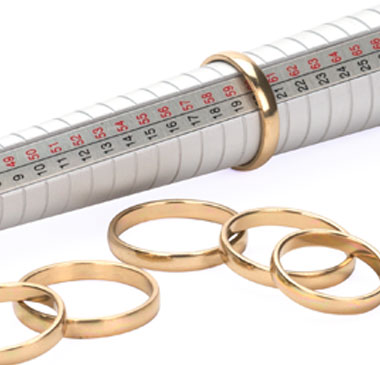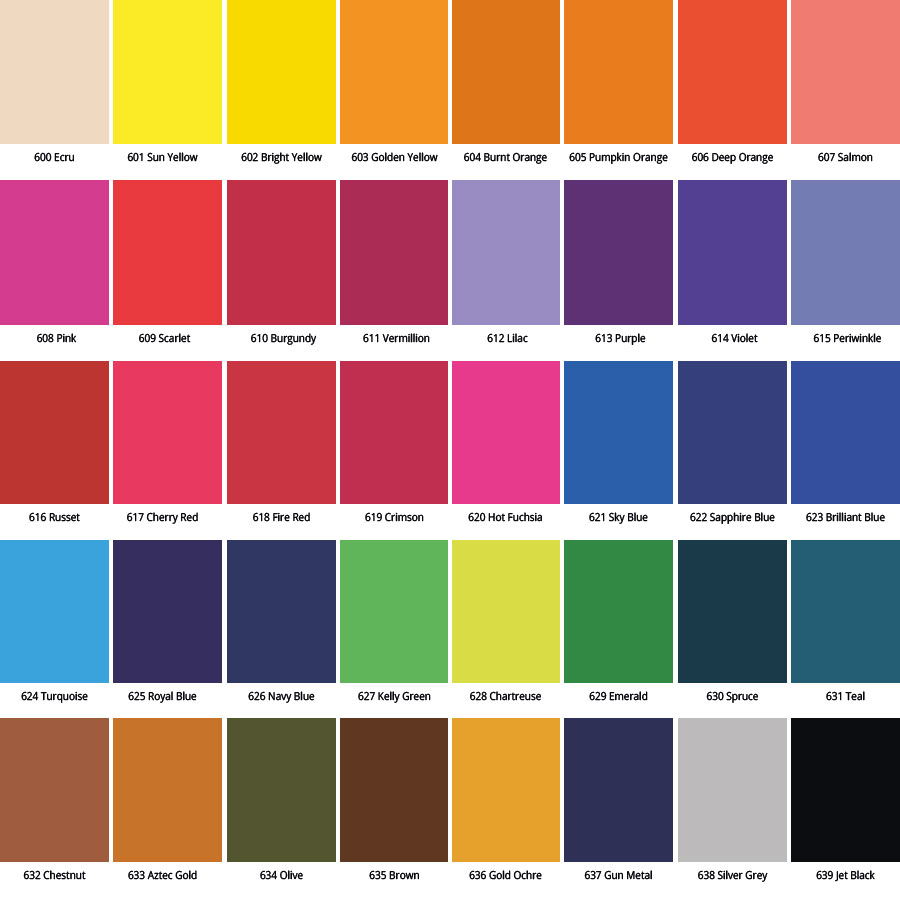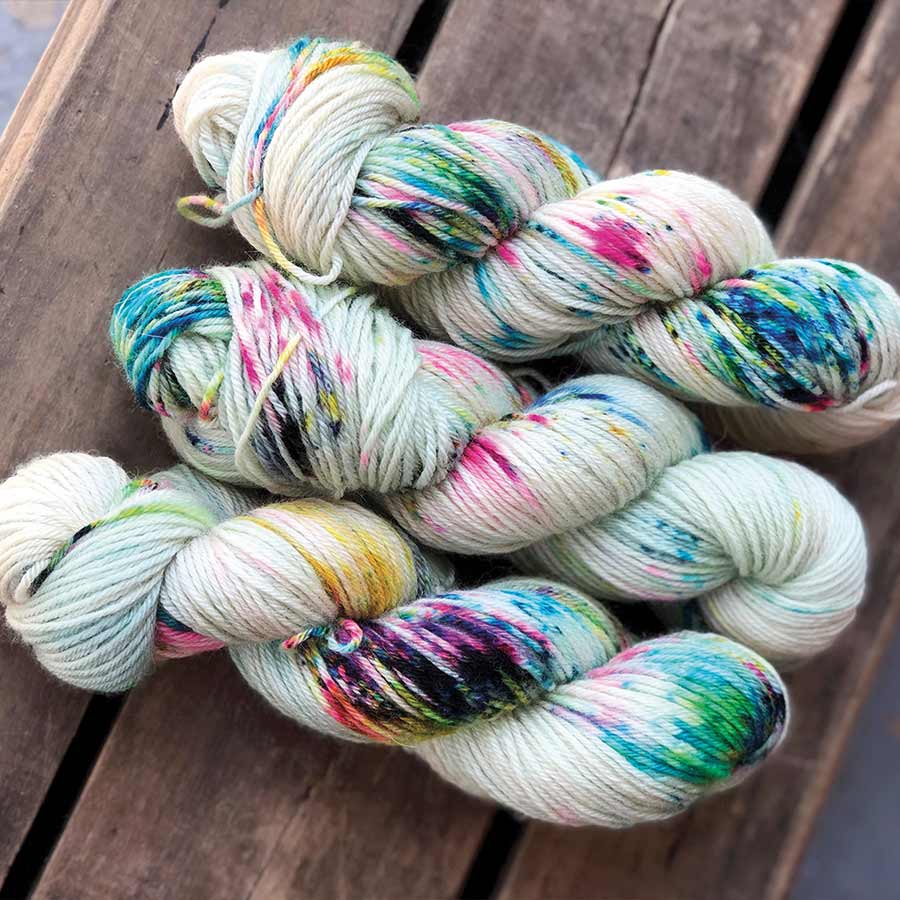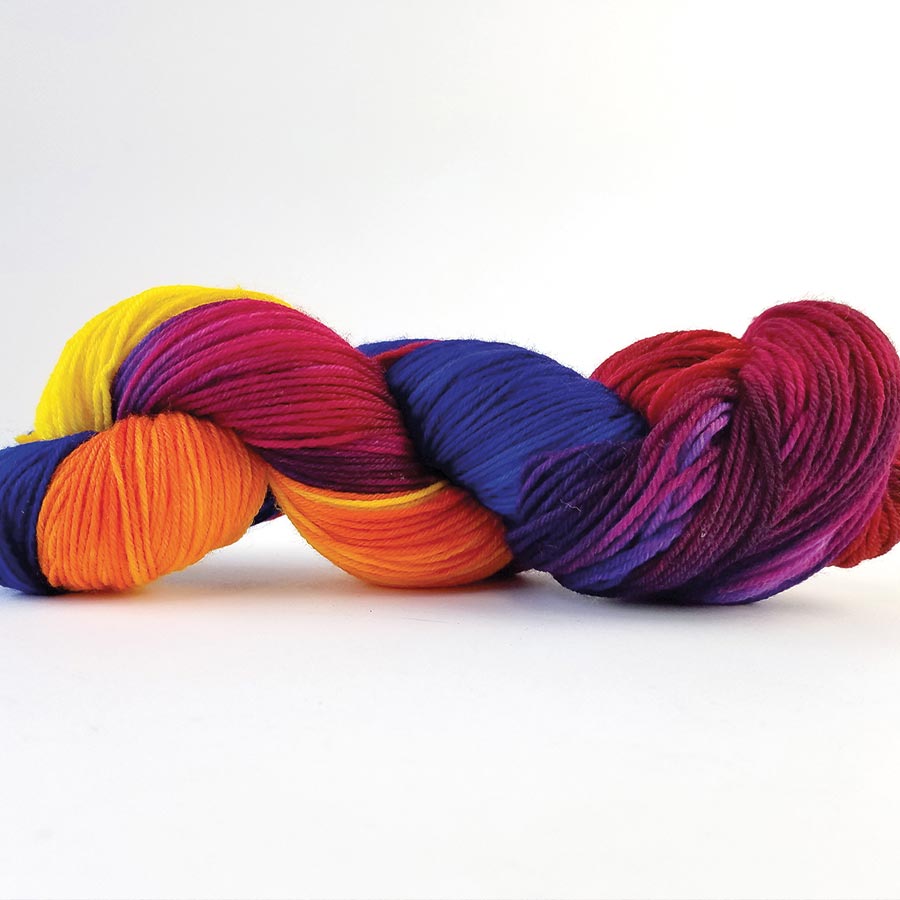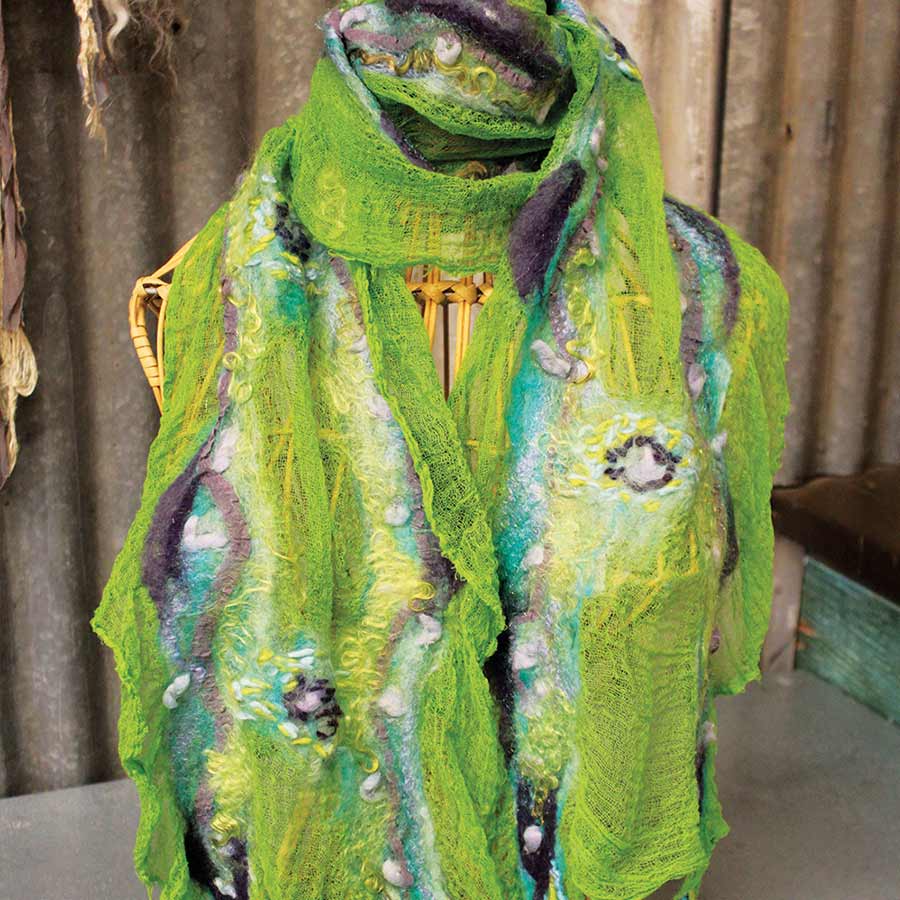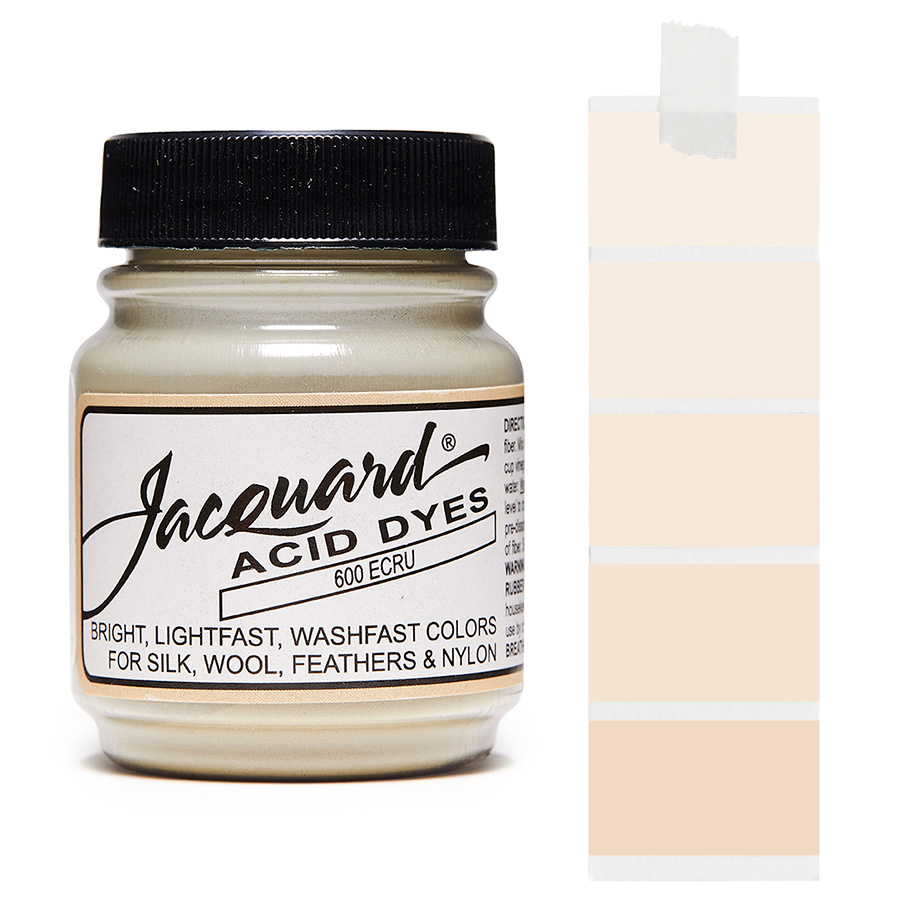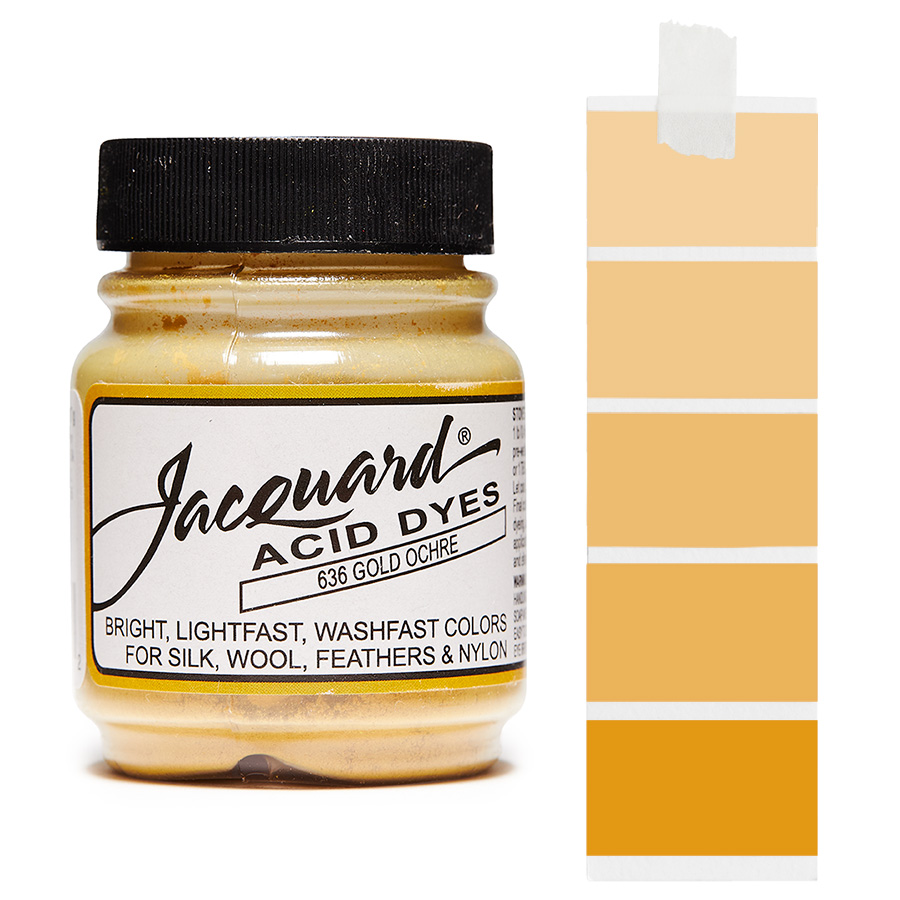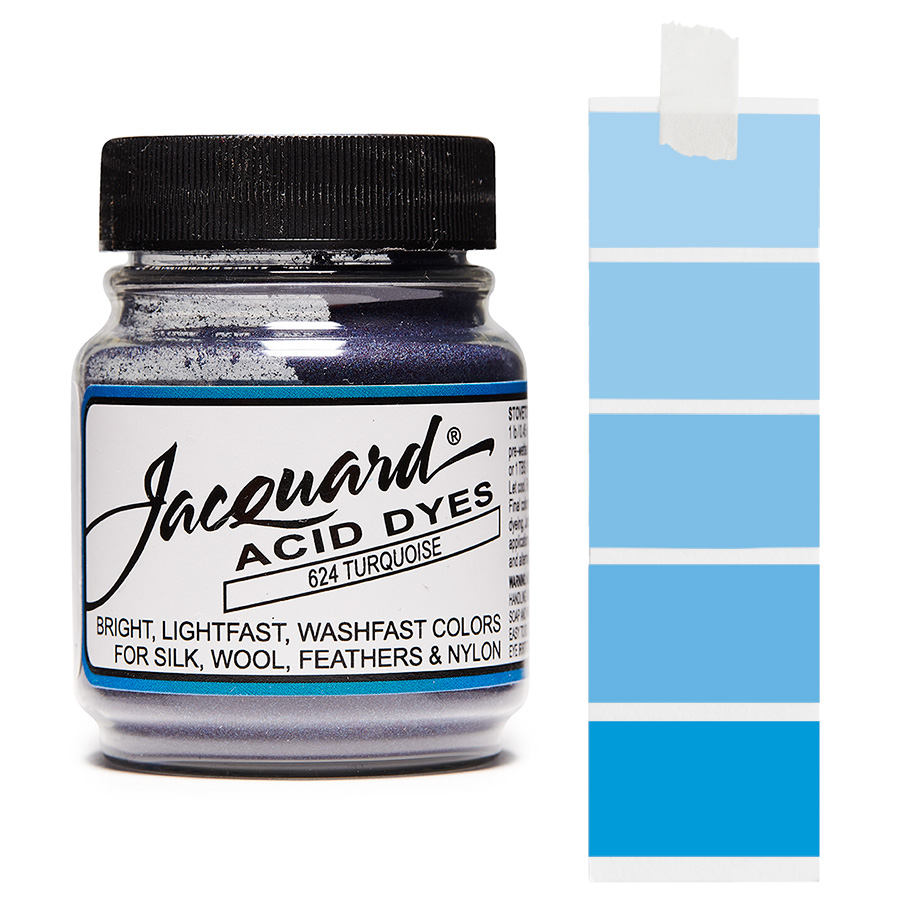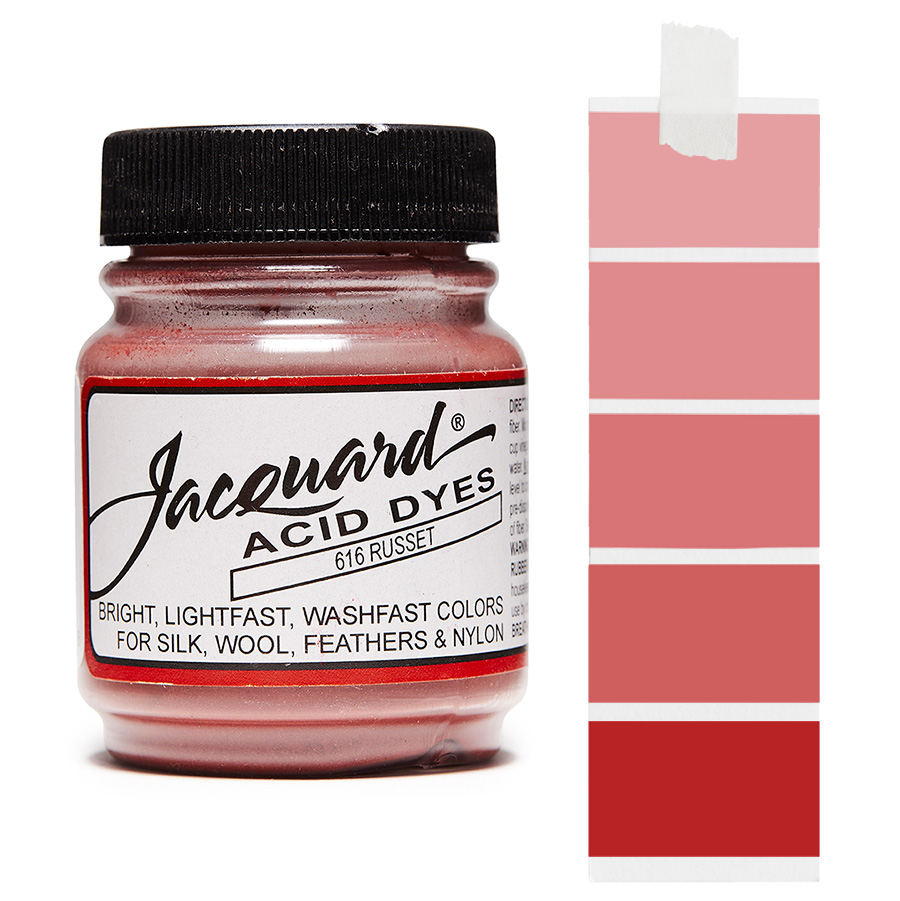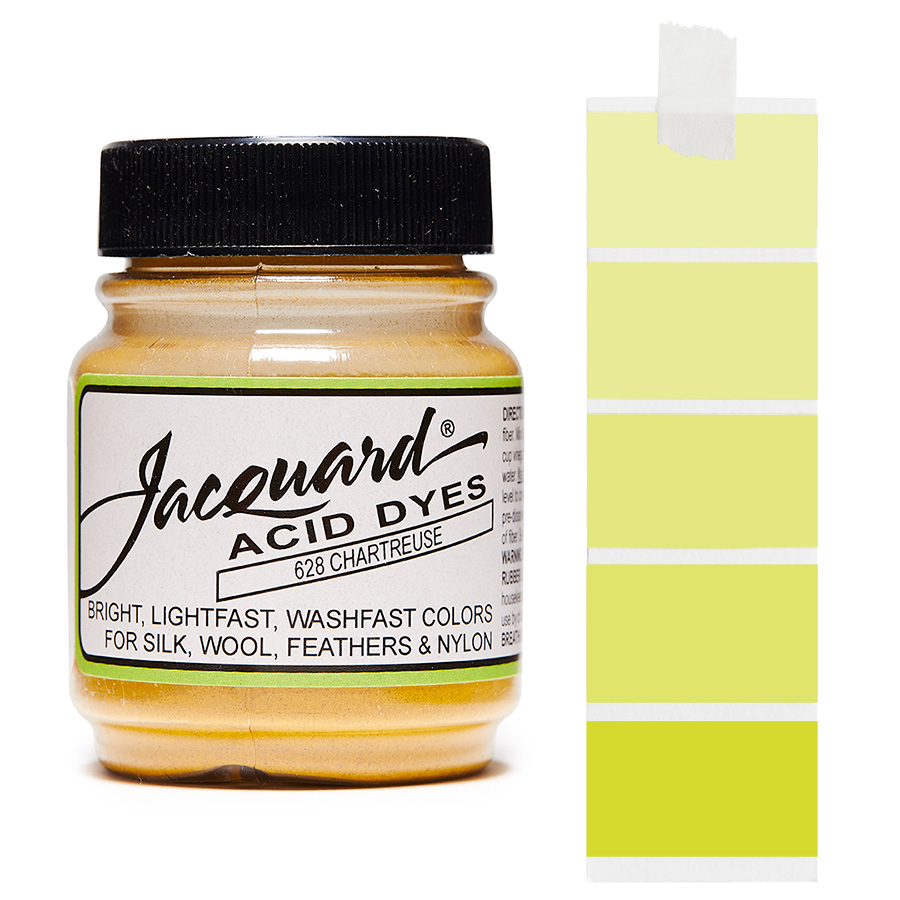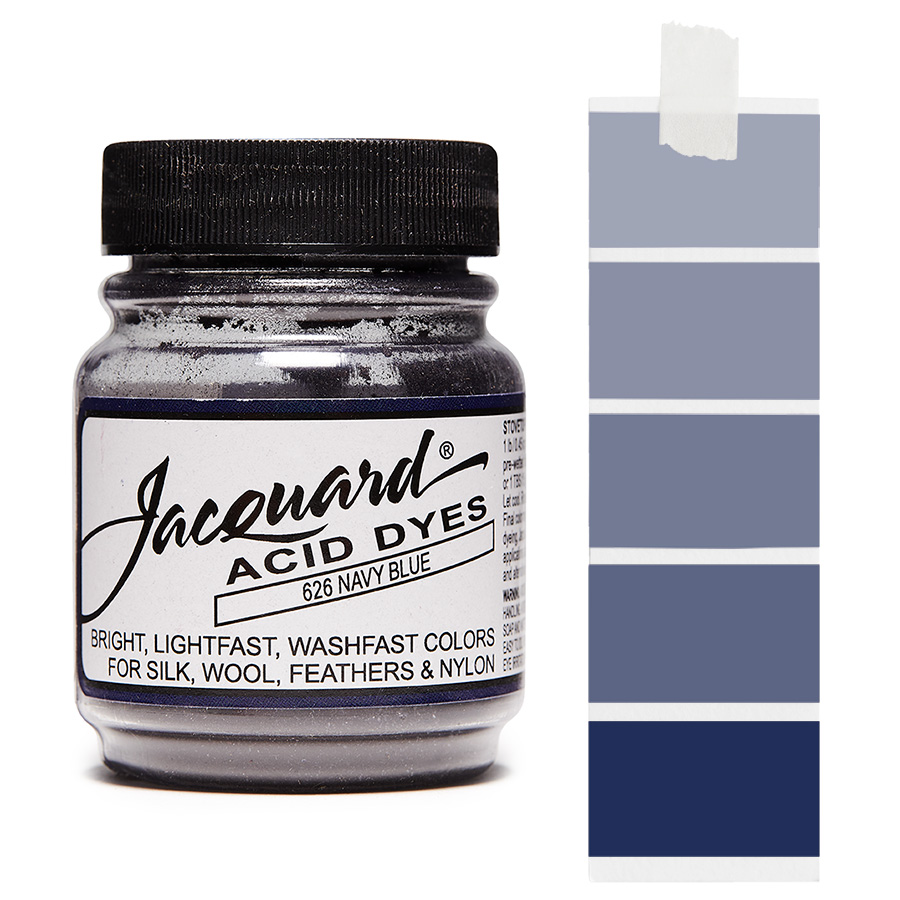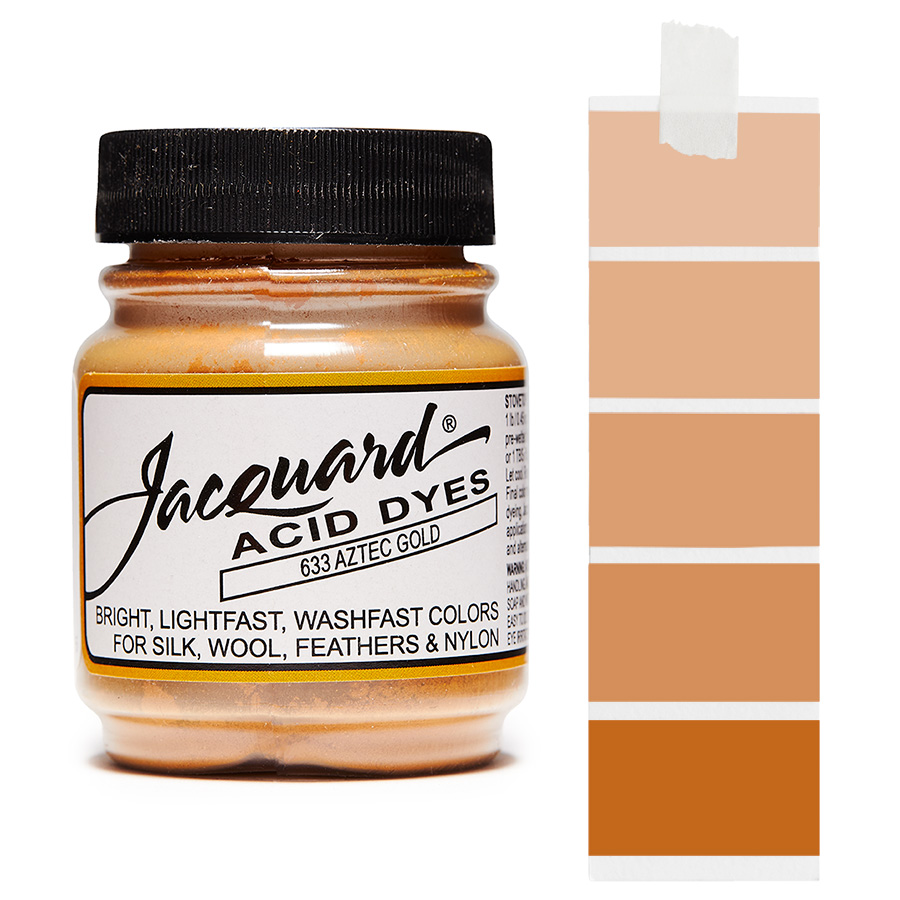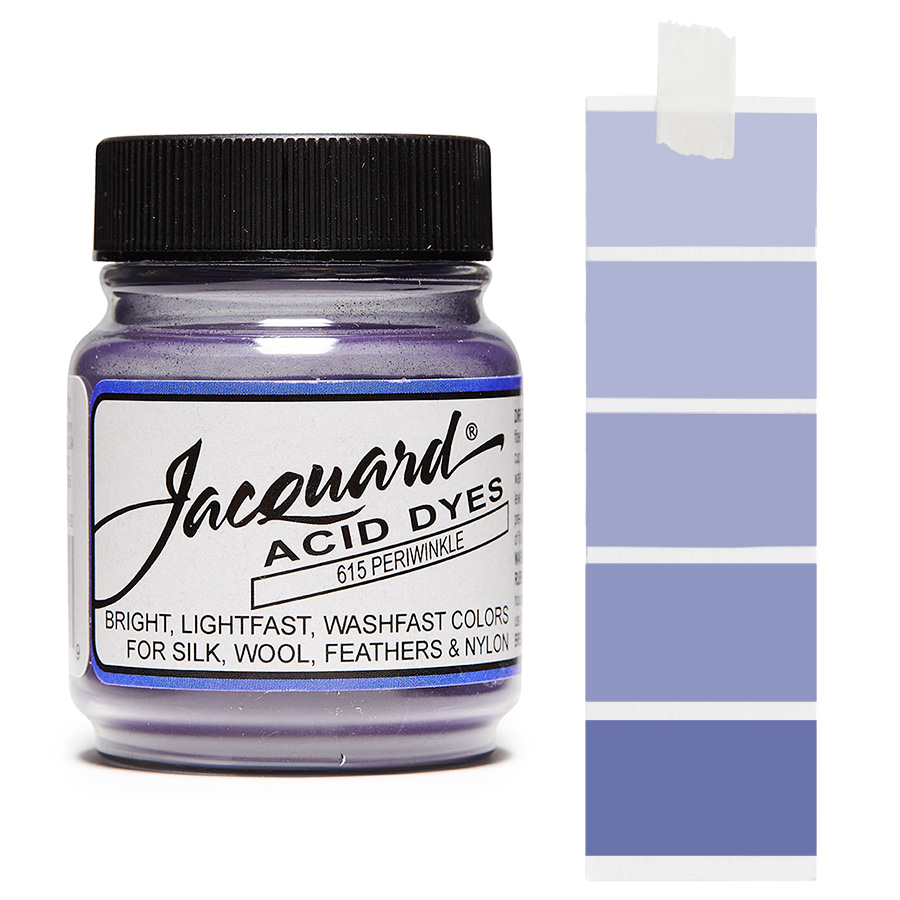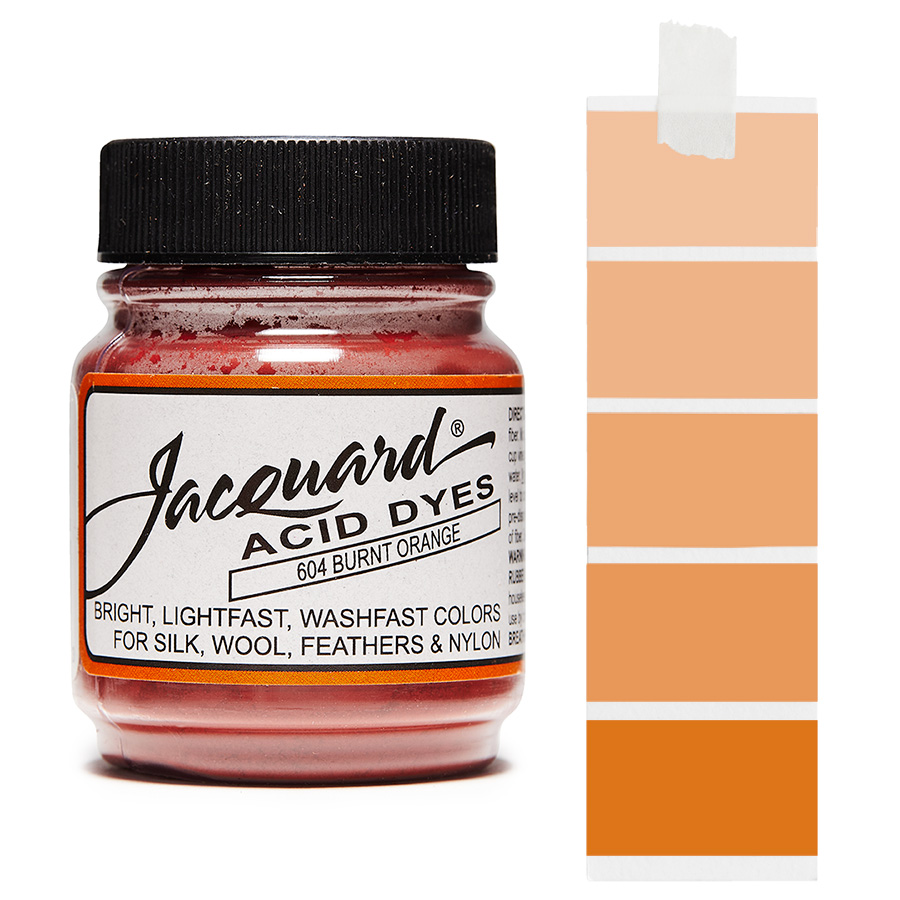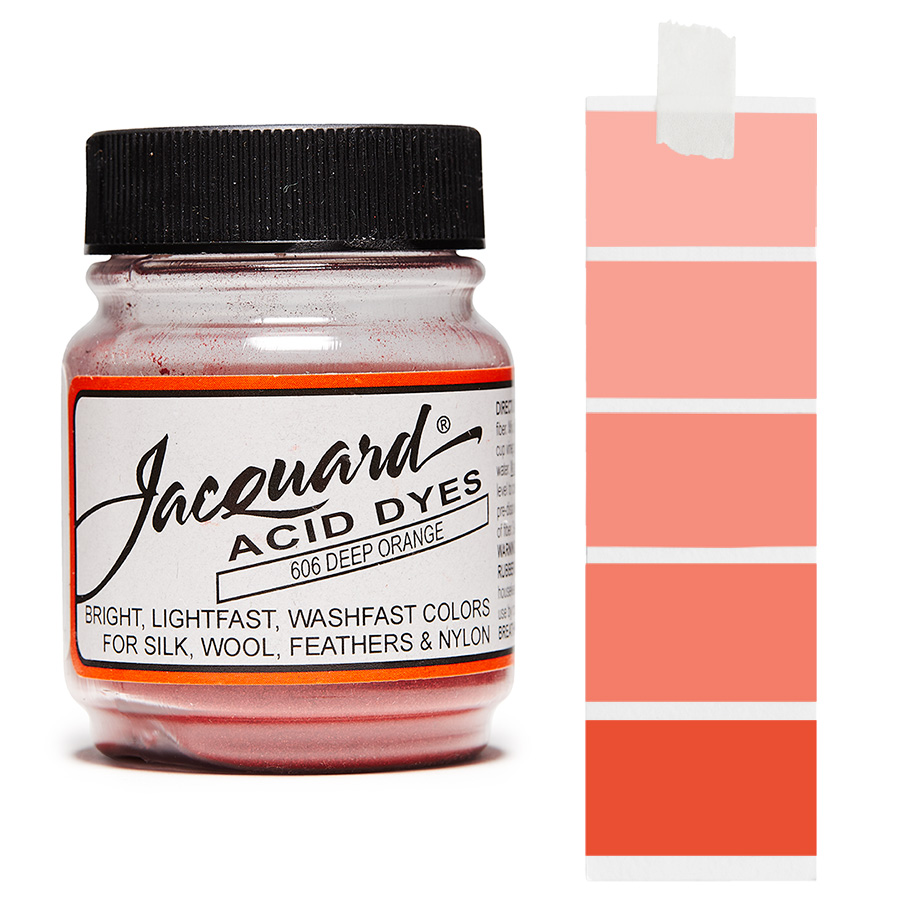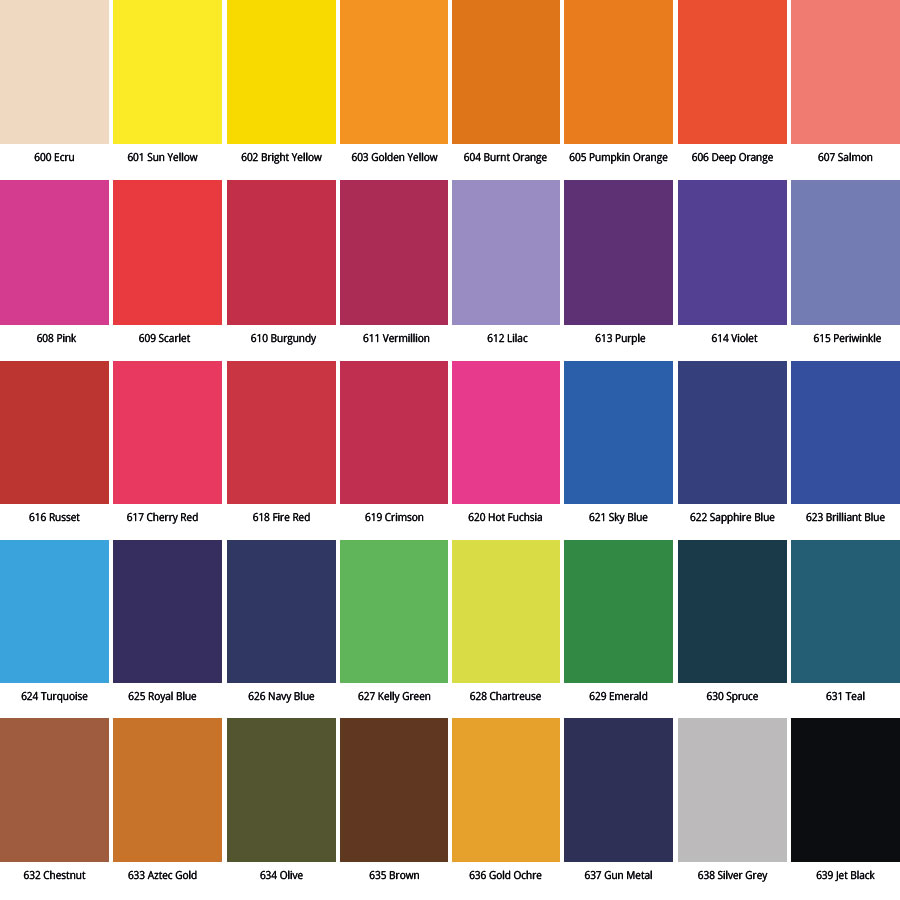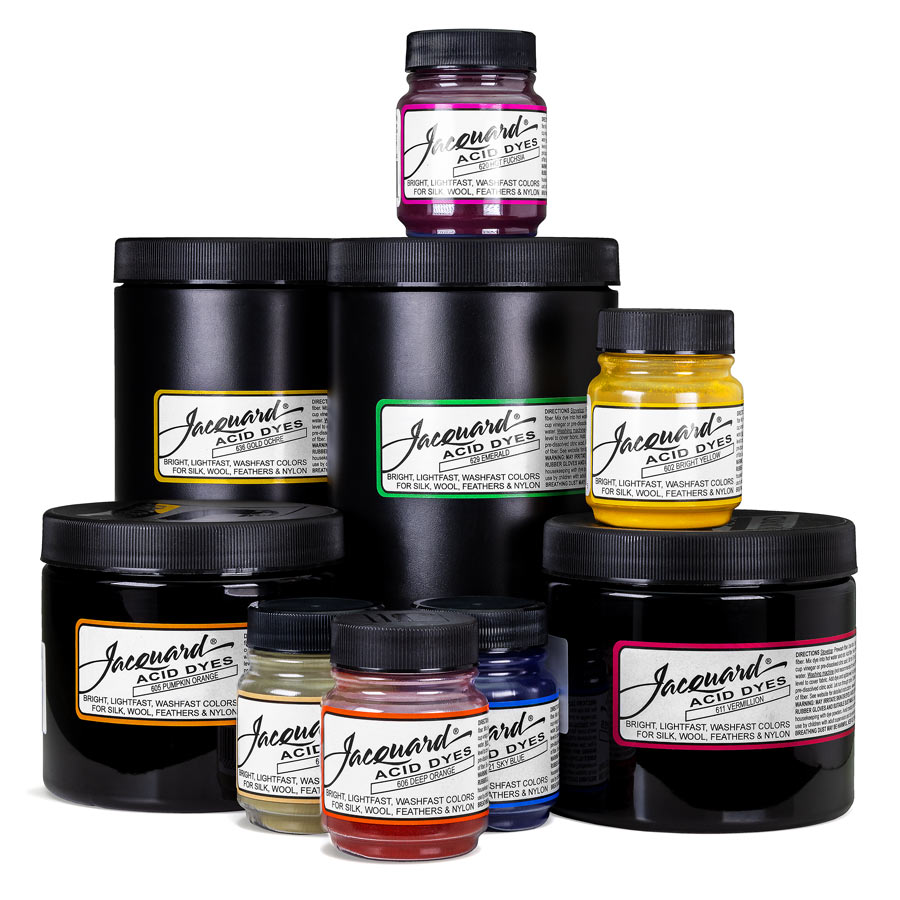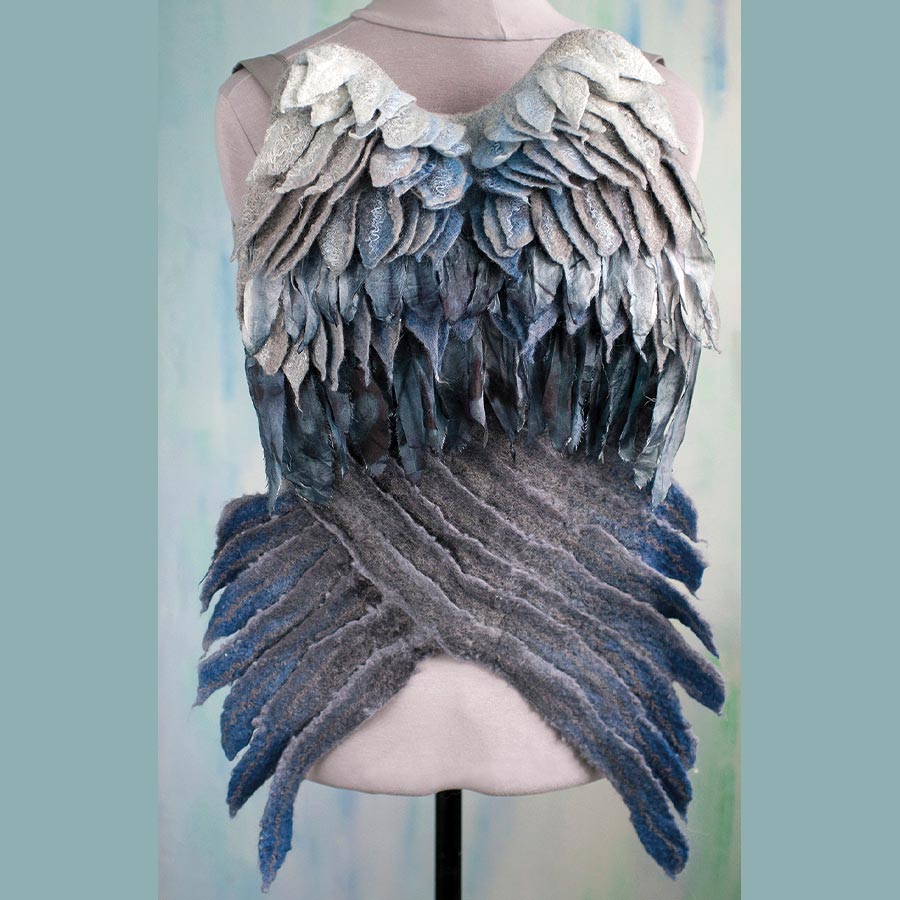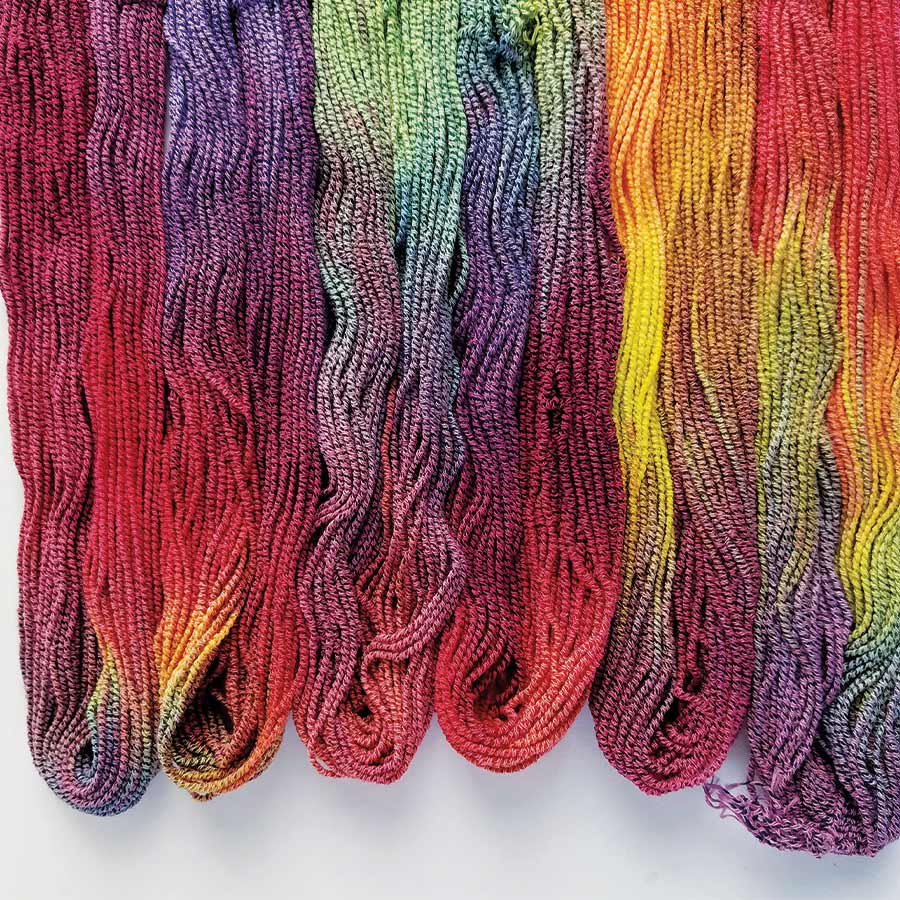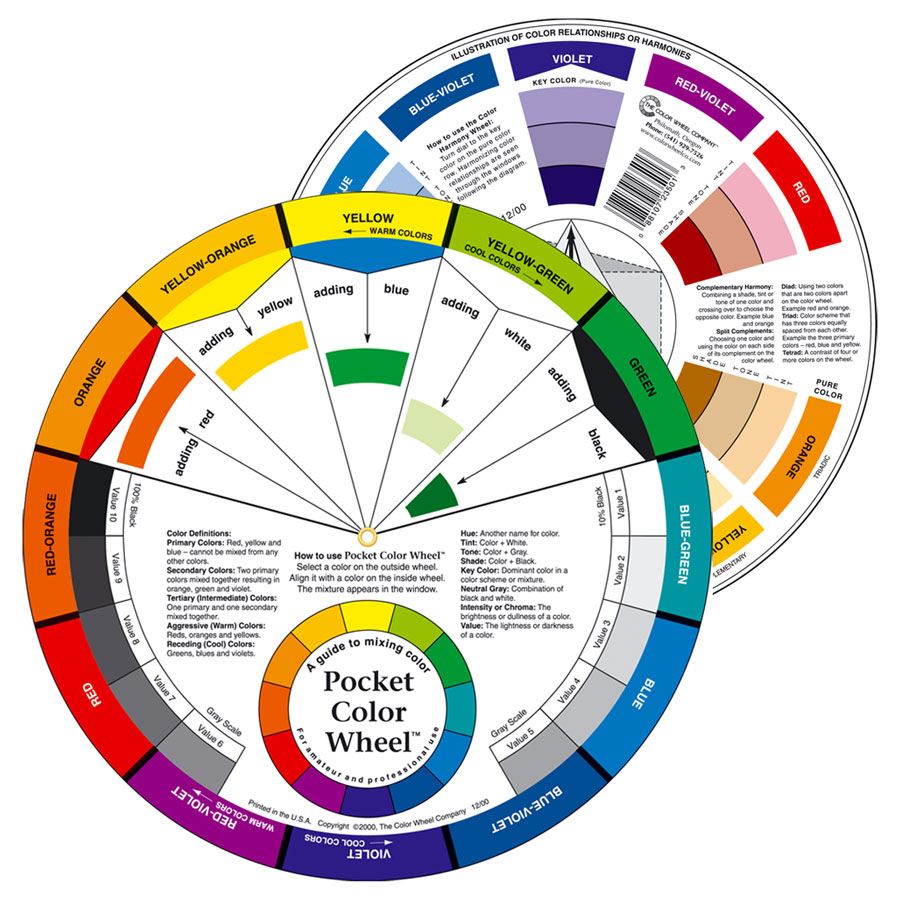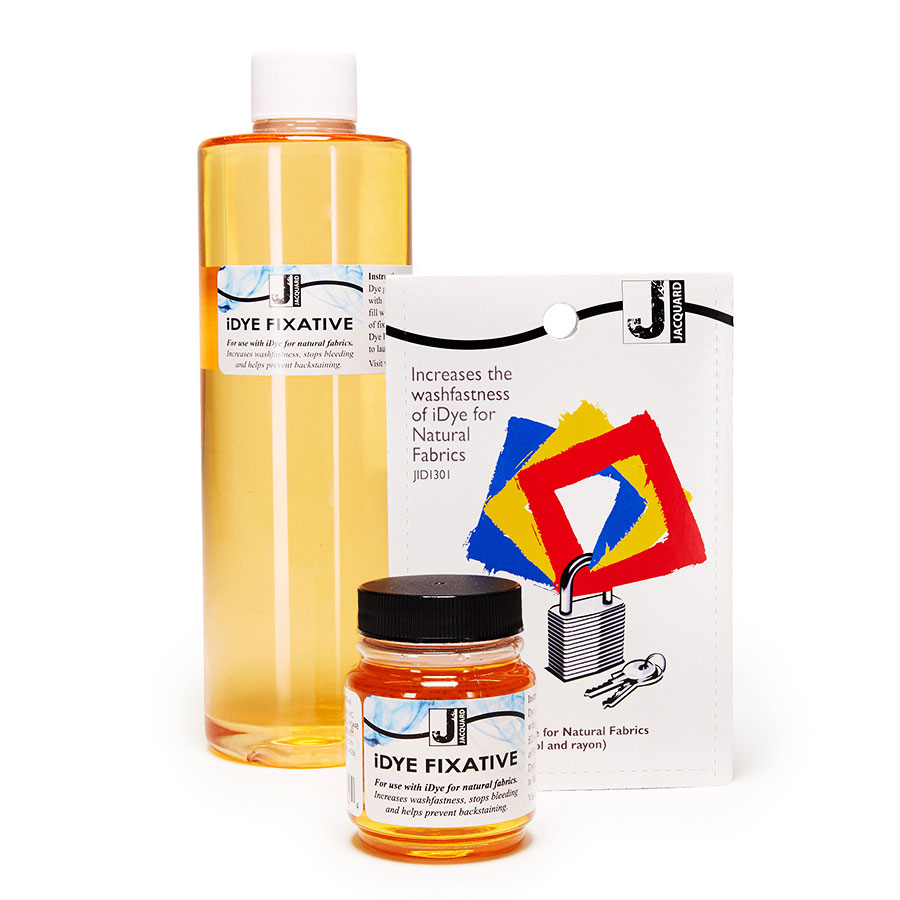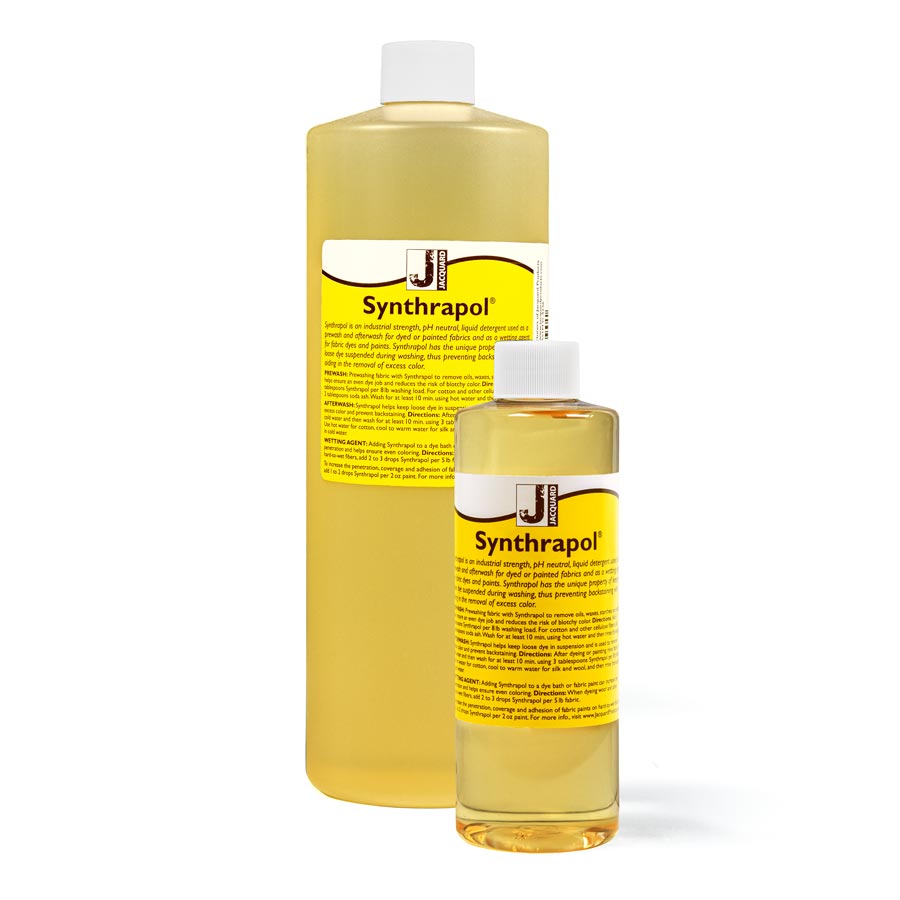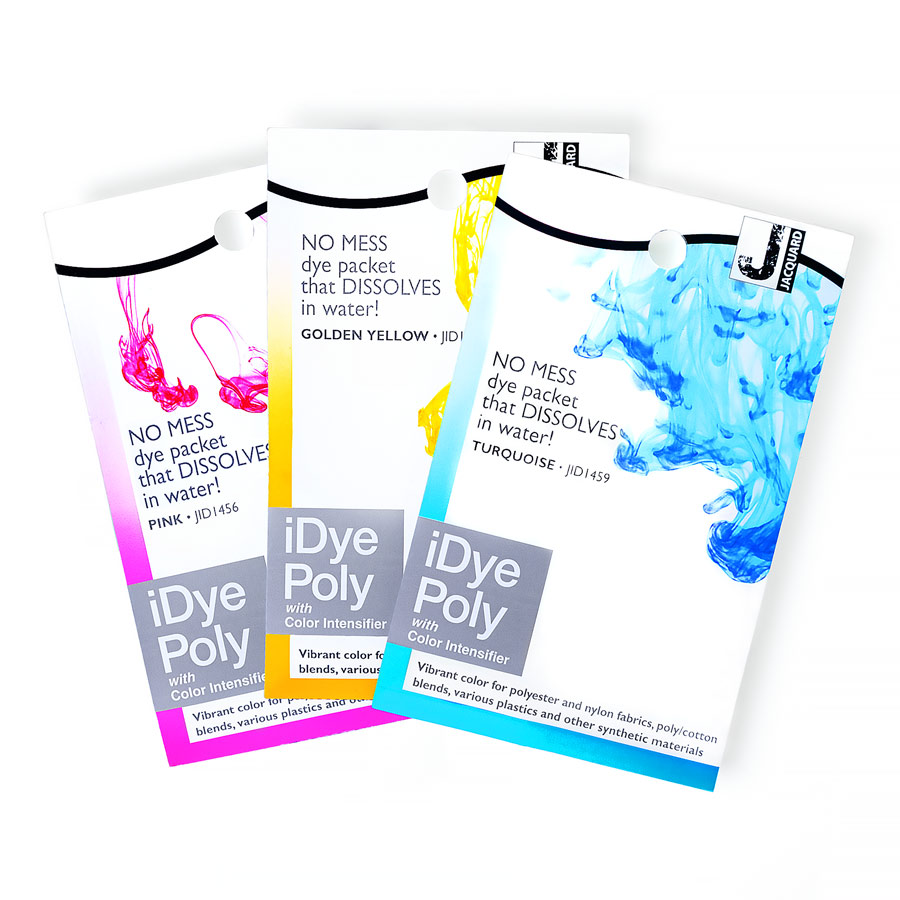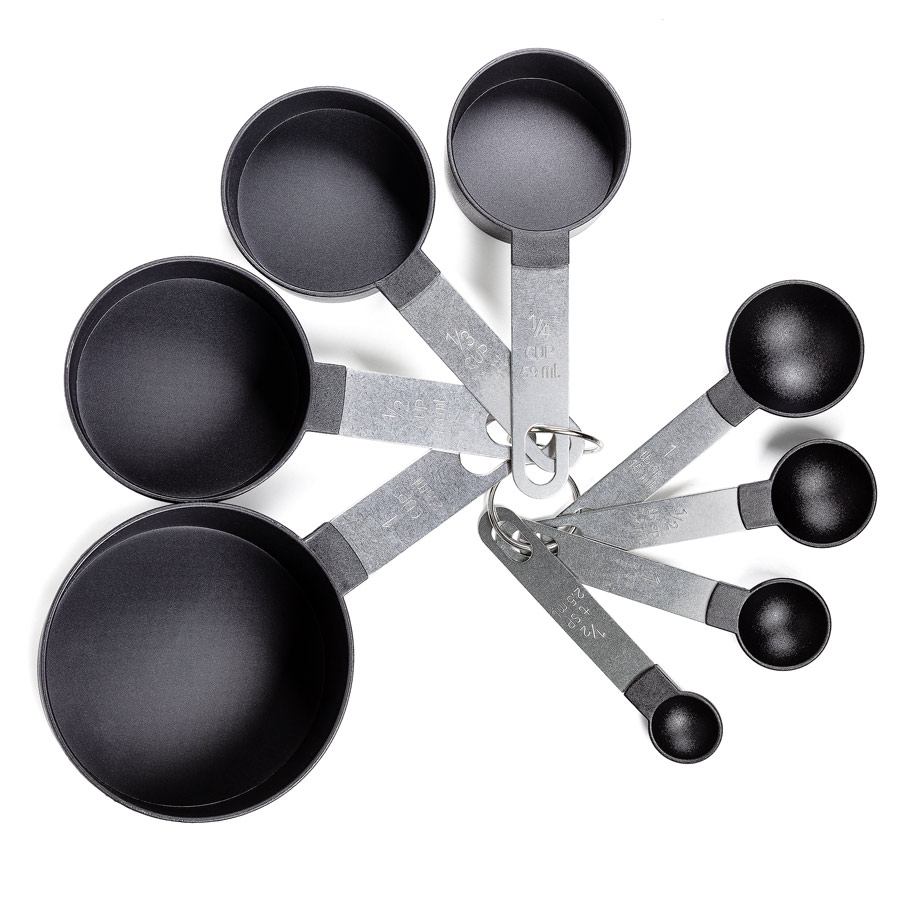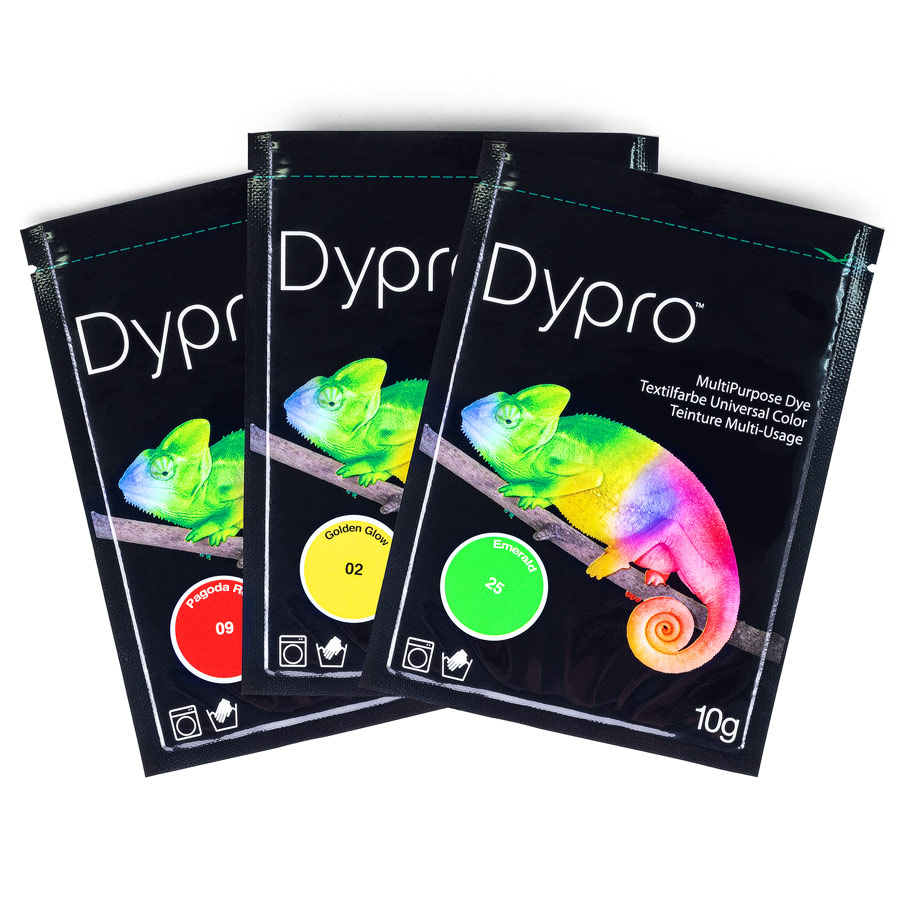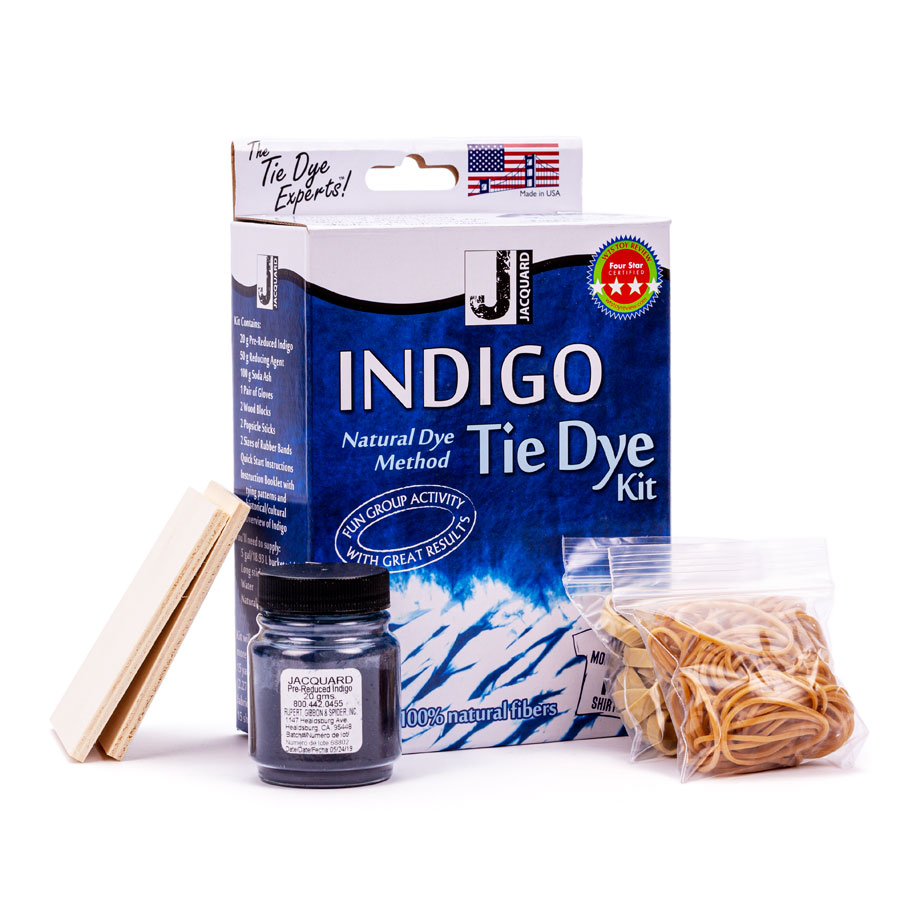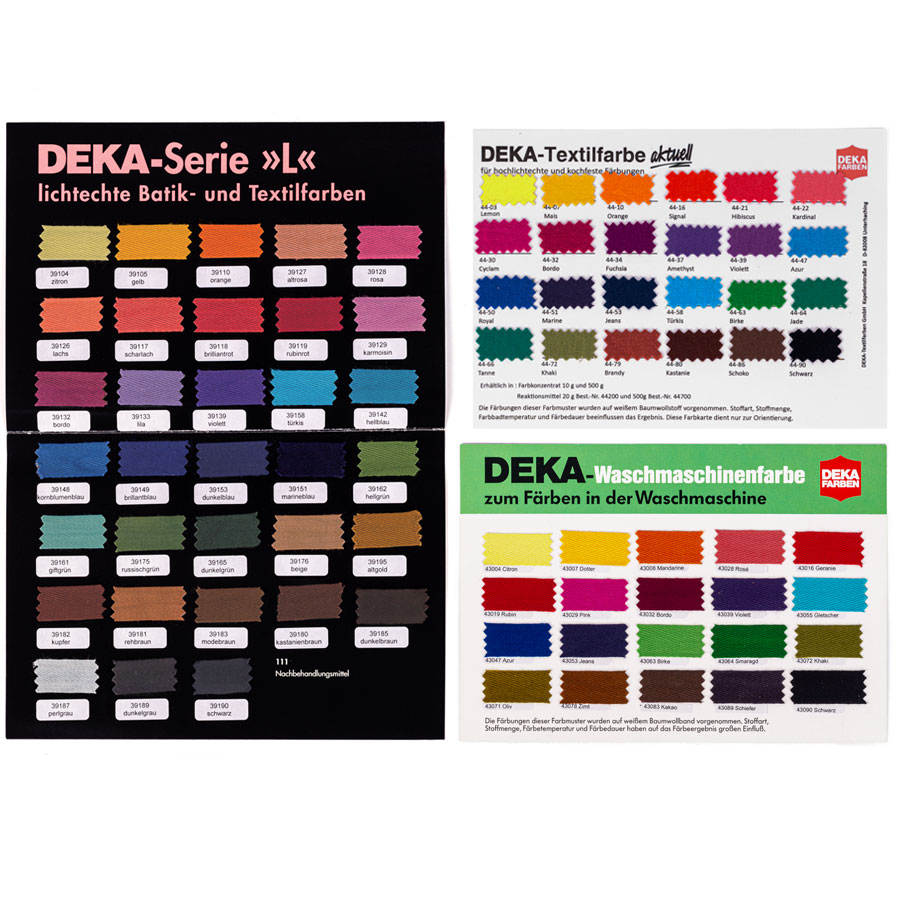Jacquard Acid Dye - Textile Dye for Wool & Silk
Available, delivery time: 1-3 days
Brand new: 8 new shades - including neon dyes & magenta
Dyeing of wool, silk, nylon - Acid Dye is the perfect textile dye
Jacquard Acid Dye for nylon and protein fibres: silk, wool, cashmere, alpaca, feathers etc.
This special Acid Dye is perfect for uniformly dyeing brilliant, colourfast shades.
Believe us - no other textile dye can achieve these intense results - only Jacquard Acid Dye in 40 shades.
The dyes are very well absorbed by the fibres and do not bleed or fade when washed.
You get one of the most versatile dyes - in addition to dyeing yarns, fibres and fabrics Jacquard Acid Dye can also be used for direct painting and printing applications where steam fixation is required.

Dyeing at very high temperatures?
The hotter you dye the more intense the colour will be. The same applies to the dye time. You should leave the textile at least for half an hour in the dye liquor to get an awesome result.
Forget about the manufacturer's recommendations on the labels! Wool and silk tolerate a hot wash without any problems - just like polyamide (nylon).
The cotton of your jeans was hot bleached and washed several times before it became a garment. And why iron cotton and linen on the highest setting if, according to the manufacturer, it cannot tolerate a temperature higher than 30°C? The same applies to wool (=hair). In the washing instructions it says that wool can only be washed cold. But you wash your hair in warm water, don't you? And it does not felt nor shrink... High spin speeds, tumble drying and a strong movement in the dye liquor are more problematic for all fibres. That makes garments shrink. Not a hot wash! And you should also avoid temperature shocks during dyeing. Never rinse wool in cold water after a hot dye bath.
Acid dyes - are they corrosive?
No - these dyes are not corrosive. Protein fibres need some acid in the dye liquor to allow the dye to penetrate the fibre.
The only acid needed is the white vinegar or citric acid that you add to the dye bath.
How do I dye with Jacquard Acid Dye?
The factors influencing dyeing are temperature, dye concentration, time and amount of fabric. Washing machine dyeing is the easiest way to dye fabrics in one colour.
However, if you want to achieve the most accurate and reproducible results or get the darkest colour, we recommend the cooking pot method.
Use the instructions as a guideline. Acid dyes are quite forgiving and open to variations in approach. The more you experiment the more you will discover!
Tip: you save on dye if you dye in a pot.
Hand dyeing in a cooking pot:
It is the best dye method for wool!
1. Fill a stainless steel or enamel pot with just enough hot or warm water (cool for wool) to allow the fabric to float freely. Turn the heat to medium.
2. Add the dye powder to the pot and stir until dissolved. Use the appropriate amount of dye for the desired shade (see chart underneath - click on the corresponding tab).
3. Wet the fabric thoroughly with warm water and put it in the dye bath.
4. Gradually increase the temperature to 85 ̊- 95 ̊ C, just below boiling point. Stir frequently.
5. Add a quarter cup of vinegar (60ml) per pound of fabric. Alternatively you could add citric acid (1 tablespoon per pound of fabric). Try not to pour the vinegar directly on the fabric.
6. Maintain the temperature and stir frequently for half an hour. Wash the fabric with Synthrapol® or a mild detergent and warm water.
NOTE: When dyeing wool, gradual heating and cooling of the dye bath is important to avoid schock reactions and matting the wool.
Washing machine dyeing:
Not suitable for wool (wool can mat in the washing machine - use the cooking pot method instead).
1. Use the appropriate amount of dye for the desired shade (see chart below - click on the corresponding tab) - between 1 and 6 packs (14,17g) of Acid Dye depending on the colour tone.
2. Dissolve the dye powder completely in hot water.
3. Set the washing machine on the longest wash cycle at a temperature of 85° - 95°C (important: the longer the wash the more intense the colour and the better the fixation)
4. Pour the dye liquor through the washing powder compartment 10 minutes after you have started the machine.
5. Add 1 to 3 cups of white vinegar (depending on water amount) and be careful not to pour the vinegar directly onto the fabric. You can also use 1 tablespoon of citric acid per pound of fabric.
6. To ensure the excess colour is completely removed you should wash the fabric in another cycle with cold water and a little Synthrapol® or mild detergent. Take the fabric out of the machine.
7. Wash a long rinse cycle to clean the machine and remove excess colour.
Recommendation:
We recommend Synthrapol by Jacquard before, during and after dyeing:
• Pre-wash to remove impregnations or finishes.
• During dyeing, a drop of Synthrapol in the dye liquor takes away the surface tension and allows the dyes to penetrate better.
• After dyeing, Synthrapol removes all free pigments and prevents subsequent discolourations.
• When hand dyeing, protect yourself with rubber gloves.
Detailed dye instructions can be found here: Acid Dye Instructions
Selling unit: 1 piece (14g, 227g or 454g)
Danger warnings:
Use product with care. Always read label and warnings before use.

Caution
May cause allergic skin reactions.
Causes severe eye irritation. Wear eye protection. If medical advice is required, have packaging or label ready.
Keep out of the reach of children.
Read label before use.
Avoid release into the environment.
Dispose of content/container according to local regulations.
How do I dye with Jacquard Acid Dye?
The factors influencing dyeing are temperature, dye concentration, time and amount of fabric. Washing machine dyeing is the easiest way to dye fabrics in one colour.
However, if you want to achieve the most accurate and reproducible results or get the darkest colour, we recommend the cooking pot method.
Use the instructions as a guideline. Acid dyes are quite forgiving and open to variations in approach. The more you experiment the more you will discover!
Tip: you save on dye if you dye in a pot.
Hand dyeing in a cooking pot:
It is the best dye method for wool!
1. Fill a stainless steel or enamel pot with just enough hot or warm water (cool for wool) to allow the fabric to float freely. Turn the heat to medium.
2. Add the dye powder to the pot and stir until dissolved. Use the appropriate amount of dye for the desired shade (see chart underneath - click on the corresponding tab).
3. Wet the fabric thoroughly with warm water and put it in the dye bath.
4. Gradually increase the temperature to 85 ̊- 95 ̊ C, just below boiling point. Stir frequently.
5. Add a quarter cup of vinegar (60ml) per pound of fabric. Alternatively you could add citric acid (1 tablespoon per pound of fabric). Try not to pour the vinegar directly on the fabric.
6. Maintain the temperature and stir frequently for half an hour. Wash the fabric with Synthrapol® or a mild detergent and warm water.
NOTE: When dyeing wool, gradual heating and cooling of the dye bath is important to avoid schock reactions and matting the wool.
The water temperature for rinsing should be the same as the temperature of the dye bath.
Washing machine dyeing:
Not suitable for wool (wool can mat in the washing machine - use the cooking pot method instead).
1. Use the appropriate amount of dye for the desired shade (see chart below - click on the corresponding tab) - between 1 and 6 packs (14,17g) of Acid Dye depending on the colour tone.
2. Dissolve the dye powder completely in hot water.
3. Set the washing machine on the longest wash cycle at a temperature of 85° - 95°C (important: the longer the wash the more intense the colour and the better the fixation)
4. Pour the dye liquor through the washing powder compartment 10 minutes after you have started the machine.
5. Add 1 to 3 cups of white vinegar (depending on water amount) and be careful not to pour the vinegar directly onto the fabric. You can also use 1 tablespoon of citric acid per pound of fabric.
6. To ensure the excess colour is completely removed you should wash the fabric in another cycle with cold water and a little Synthrapol® or mild detergent. Take the fabric out of the machine.
7. Wash a long rinse cycle to clean the machine and remove excess colour.
Acid Dye amounts for dyeing in the washing machine
Here is a general dye amount chart to give you an idea of how much Acid Dye you should take per colour.
The amounts listed below are for the deepest colour saturation.
For pastels and lighter colours, use less dye. Dye amounts are per pound of fabric (you need less dye for the cooking pot method).
Do not exceed 8 % of dye per pound of dry fabric.
7 - 14g of Acid Dye
600 Ecru
601 Yellow Sun
602 Bright Yellow
603 Golden Yellow
605 Pumpkin Orange
607 Salmon
608 Pink
636 Gold Ochre
638 Silver Grey
14 - 42g of Acid Dye
604 Burnt Orange
610 Burgundy
620 Hot Fuchsia
627 Kelly Green
628 Chartreuse
633 Aztec Gold
634 Olive
616 Russet
617 Cherry Red
42 - 57g of Acid Dye
606 Deep Orange
609 Scarlet
611 Vermillion
612 Lilac
613 Purple
614 Violet
615 Periwinkle
621 Sky Blue
622 Sapphire Blue
623 Brilliant Blue
624 Turquoise
625 Royal Blue
629 Emerald
630 Spruce
631 Teal
637 Gun Metal
Up to 85g of Acid Dye
618 Fire Red
632 Chestnut
639 Jet Black
626 Navy Blue
635 Brown
How do I make silk paint with Jacquard Acid Dye?
For professional silk painters who steam fix, acid dyes offer the brighest, most intense colours.
To make your own liquid silk paints for silk painting, use the following recipe:
1. Add 1 cup (240ml / 8 oz.) of very hot water to a 14g (1⁄2 oz.) pack of Jacquard Acid Dye.
2. Stir until completely dissolved. A very concentrated dye stock solution is produced. Most colours need to be further diluted.
NOTE: Each colour has a different solubility. Some colours are hardly soluble, but most are easily soluble. A small amount of alcohol (approx. 1 table spoon) can be added to the dye solution as a wetting agent.
3. The final concentration of the dye solution for painting should be between 4 and 8 %. Start with adding 120ml of water to the 240ml dye stock solution. Test the colour and add more water until the desired colour tone is reached.
Please note that the colour intensity only really develops during steam fixation. Most colours remain stable in the solution over a long period of time. However, some colours fall out of the solution when it cools down or is left to stand for weeks. To restore them, simply heat them on the cooker.
Screen printing, stamping and painting with Jacquard Acid Dye?
The traditional method of printing with dye is to add the dye to a thickening paste. This process can be used for screen printing, hand painting and embossing and many other direct application techniques. It is important to prepare the fibre by washing to remove the sizing.
1. Wash, dry and iron the fabric.
2. Prepare the dye thickening paste (see below).
3. Add dye, either powder or stock solution, to the thickener. Pay attention to the correct proportion of dye in the container in relation to the amount of thickening paste and the desired intensity.
4. Print, paint or stamp the fabric.
5. Air dry. Steam set (following the instructions for steaming).
Preparation of the dye thickener:
When screen printing with sodium alginate thickened dye, the dye application should be as thin as possible. Dye that is applied/printed too thick may fall off the painting before the fabric has hardened. Or it may accumulate in the corners.
Sodium alginate is a high viscosity low solids alginate thickener mainly used for cotton and other cellulosic fibres.
It can also be used for silk when fine line definition is not required.
1. Mix 57g of urea and 15ml of vinegar with 1 litre of water.
2. Sprinkle the sodium alginate into the water and stir for 10 minutes OR stir with a blender.
3. Leave to rest for a few hours or overnight before use. The mixture can be stored in the fridge for many months.
Steam fixing of dyed fabrics
With the following instructions you can easily create your own fabric steamer for steaming small dye projects.
Before you start, make sure you are using the appropriate dye for the type of fabric you are treating.
You need:
• Blank newsprint, wrapping (even better: butcher paper) or uncolored art paper
• Aluminium foil
• 1 ceramic plate
• 3 ceramic coffee mugs
• 1 deep metal stock pot (or canning pot) with a lid
• Rubber bands or string
Instructions:
1. The fabric has to be rolled up in paper so it does not touch itself during steaming to avoid back-staining.
For that purpose, lay your fabric flat on a sheet of blank newsprint paper, butcher paper or art paper. The paper should be 60cm longer than the fabric.
2. Roll the fabric together with the paper into a tube beginning from one end.
3. Now roll the tube into a coil like a cinnamon bun.
4. Tie the coil with string or rubber bands. Do not use adhesive tape (that would draw water to the paper).
5. Place a big stock pot or canning pot on other deep metal pot on the stove.
Place 3 ceramic coffee cups or ceramic coffee mugs upside down on the bottom of the pot.
6. Fill water into the pot to cover the mugs halfway.
IMPORTANT: tilt each cup slightly to make sure the water level is the same inside and outside of the cups.
7. Cut two circles of aluminum foil big enough to cover the bottom of all three cups.
Place the paper coil between the two foils. As an alternative you can also use a plate turned upside down over the cups and cover the paper coil with aluminium foil.
8. Place the lid on the pot to keep the steam inside and let the water boil slightly for 30 minutes.
CAUTION: do not let the water completely boil away!
9. Allow the fabric roll to cool, roll it up and wash the fabric with a mild detergent.
Good luck!
10 of 10 reviews
5 out of 5 stars
Login
March 18, 2024 08:29
Wolle färben
Ich muss sagen, dass ich am Anfang eher skeptisch war einen Cashmere Pullover so heiss zu färben! Habe mich genau nach der „Anleitung im Topf färben“ gehalten und bin restlos begeistert!! Wunderschöne und brillante Farben und der Pullover flauschig weich. Vielen Dank!
February 14, 2024 10:06
Teinture pour cachemire/laine
Merci pour vos bons produits et conseils d utilisation. Teinture de mon pull cachemire qui était bleu ciel mais taché je l ai teint en bleu marine super résultat pull comme neuf. Produit reçu rapidement. Votre site est super bien fait.
January 26, 2024 11:24
Klasse Farben
Habe Farbe für meine Wolle gekauft. Alles super easy. QR Code für die Anleitung war dabei. Die Farben sind kräftig und wunderschön. Herzlichen Dank dafür!
August 18, 2023 12:25
JACQUARD ACID DYE - Aztec Gold
Ich habe mit dieser Farbe einen dünnen Kaschmirpullover gefärbt, er hatte vorher ein sehr blasses unscheinbares Beige und jetzt hat er einen wunderbaren satten Bernsteinton. Ich habe den Pullover im Topf gefärbt, wie in der Anleitung angegeben und das hat wunderbar geklappt, auch die hohe Temperatur von knapp 90°C hat dem Material nicht geschadet. Die Lieferung war wie immer schnell und die süße Beilage ist eine sehr nette Aufmerksamkeit. Prima finde ich auch, dass man auf der Website vorher genau nachlesen kann, wie man färben und was man beachten muss und was man alles braucht, dann kann man schon mal alles vorbereiten und gleich loslegen, wenn das Paket kommt. Das war sicherlich nicht das letzte Mal, dass ich hier bestellt habe.
November 17, 2022 09:26
Schnell und gut
Ich war auf der Suche nach einer Möglichkeit, einen Kaschmir Pullover zu färben. Die ausführliche Information auf der Homepage hat mir Mut gemacht, es zu versuchen. Ich habe die erforderlichen Produkte bestellt, sie kamen schnell an und ich bin der Anleitung gefolgt. Siehe da, der Pullover ist so schön weich wie zuvor und die Flecken nicht mehr sichtbar. Toll!
July 16, 2022 10:26
Immer wieder gerne
Tolle Farben! Vielen Dank. (Wenn das so weitergeht, habe ich bald die ganze Farbpalette durch :-D )
February 11, 2022 21:48
Tolle Farben ,super deckend!
Bin sehr zufrieden mit meiner ersten Bestellung. Habe zeitnah die Farben verwendet. Super Verarbeitung möglich,gut deckend,wie beschrieben. Schnelle Lieferung.
January 27, 2022 09:39
Professionell und preiswert
Habe erstmalig Färbe-Produkte gekauft und es war auch ein etwas komplizierter Prozess (Wolle) es gab noch Aufklärungsbedarf: aber Herr Knoll hat sich die Zeit genommen den Vorgang nochmals genau zu erklären. Am Ende war das Ergebnis besser als ich erwartet hatte. Gute Adresse!
December 1, 2021 12:38
Unglaubliche Farben
Ich habe naturfarbenen Wolle mit dieser Farbe gefärbt. Noch nie hatte ich solch brillante Farben nach der Färbung. Bei dieser Farbe lohnt sich jeder Cent! Ab sofort gibts nur noch Farben von Jacquard. Vielen Dank - Carola
November 27, 2021 13:19
wahnsinns produkt, prima versand
dachte, ich brauch 4 döschen jaquard acid dye für einen wollpulli, brauchte nur 1! wahrscheinlich krasse chemie? danke für die sweete beiladung!
Accessories
Content: 0.025 Litre (€118.00* / 1 Litre)
Content: 0.25 Litre (€27.80* / 1 Litre)
Content: 0.234 Litre (€55.34* / 1 Litre)
Content: 14 Kilogram (€0.57* / 1 Kilogram)
Content: 0.014 Kilogram (€710.71* / 1 Kilogram)
Content: 0.236 Litre (€33.69* / 1 Litre)
Similar Products
Content: 0.023 Kilogram (€302.17* / 1 Kilogram)
Content: 22 Gram (€0.84* / 1 Gram)
Content: 10 Gram (€0.45* / 1 Gram)
Content: 14 Gram (€0.46* / 1 Gram)
Content: 10 Gram (€0.30* / 1 Gram)
Customer Also Viewed
Content: 0.227 Kilogram (€250.88* / 1 Kilogram)
Content: 4 Piece (€3.24* / 1 Piece)
Customer Also Bought
Content: 14 Gram (€0.57* / 1 Gram)
Content: 0.5 Kilogram (€3.70* / 1 Kilogram)
Content: 0.014 Kilogram (€389.29* / 1 Kilogram)
Content: 14 Gram (€0.57* / 1 Gram)
Content: 0.5 Kilogram (€129.90* / 1 Kilogram)
Content: 10 Gram (€0.32* / 1 Gram)
Content: 0.5 Kilogram (€149.90* / 1 Kilogram)
 We ship worldwide
We ship worldwide Top customer satisfaction!
Top customer satisfaction! Many payment options
Many payment options






